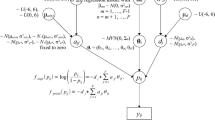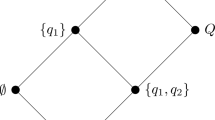Abstract
The generalized logit–linear item response model (GLLIRM) is a linearly constrained nominal categories model (NCM) that computes the scale and intercept parameters for categories as a weighted sum of basic parameters. This paper addresses the problems of the identifiability of the basic parameters and the equivalence between different GLLIRM models. It is shown that the identifiability of the basic parameters depends on the size and rank of the coefficient matrix of the linear functions. Moreover, two models are observationally equivalent if the product of the respective coefficient matrices has full column rank. Finally, the paper also explores the relations between the parameters of nested models.
Similar content being viewed by others
References
Andersen, E. B. (1980). Discrete statistical models with social science applications. Amsterdam: North-Holland.
Bartels, R. (1985). Identification in econometrics. The American Statistician, 39, 102–104.
Bechger, T. M., & Maris, G. (2004). Structural equation modelling of multiple facet data. Extending models for multitrait–multimethod data. Psicológica, 25, 253–274.
Bechger, T. M., Verhelst, N. D., & Verstralen, H. F. M. (2001). Identifiability of nonlinear logistic test models. Psychometrika, 66, 357–371.
Bechger, T. M., Verstralen, H. F. M., & Verhelst, N. D. (2002). Equivalent linear logistic test models. Psychometrika, 67, 123–136.
Bejar, I. I. (1993). A generative approach to educational and psychological measurement. In N. Frederiksen, R. J. Mislevy & I. I. Bejar (Eds.), Test theory for a new generation of tests (pp. 199–217). Mahwah: Lawrence Erlbaum.
Bejar, I. I., Lawless, R. R., Morley, M. E., Wagner, M. E., Bennett, R. E., & Revuelta, J. (2002). A feasibility study of on-the-fly adaptive testing. Journal of Technology, Learning and Assessment, 2, 4–29.
Birnbaum, A. (1968). Some latent trait models and their use in inferring an examinee’s ability. In F. M. Lord & M. R. Novick (Eds.), Statistical theories of mental tests scores. Reading: Addison-Wesley.
Bock, R. D. (1972). Estimating item parameters and latent ability when responses are scored in two or more nominal categories. Psychometrika, 37, 29–51.
Bock, R. D. (1997). The nominal categories model. In W. J. van der Linden & R. K. Hambleton (Eds.), Handbook of modern item response theory. New York: Springer.
Bock, R. D., & Aitkin, M. (1981). Marginal maximum likelihood estimation of item parameters: Application of an EM algorithm. Psychometrika, 46, 443–459.
Bock, R. D., & Moustaki, I. (2007). Item response theory in a general framework. In C. R. Rao & S. Sinharay (Eds.), Handbook of statistics. Psychometrics. Amsterdam: Elsevier.
Embretson, S. (1999). Generating items during testing. Psychometric issues and models. Psychometrika, 64, 407–433.
Fischer, G. H. (1981). On the existence and uniqueness of maximum-likelihood estimates in the Rasch model. Psychometrika, 46, 59–77.
Fischer, G. H. (1983). Logistic latent trait model with linear constraints. Psychometrika, 48, 3–26.
Fischer, G. H. (1995). The linear logistic test model. In G. H. Fischer & I. W. Molenaar (Eds.), Rasch models: foundations, recent developments and applications. New York: Springer.
Fischer, G. H. (1997). Unidimensional linear logistic Rasch models. In W. v. der Linden & R. K. Hambleton (Eds.), Handbook of modern item response theory. New York: Springer.
Fischer, G. H. (2004). Remarks on “Equivalent linear logistic test models” by Bechger, Verstralen, and Verhelst (2002). Psychometrika, 69, 305–315.
Fischer, G. H., & Molenaar, I. W. (1995). Rasch models. Foundations, recent developments and applications. New York: Springer.
Fischer, G. H., & Ponocny, I. (1994). An extension of the partial credit model with an application to the measurement of change. Psychometrika, 56, 177–192.
Hsiao, C. (1983). Identification. In Z. Griliches & M. D. Intriligator (Eds.), Handbook of econometrics, Vol. I. Amsterdam: North-Holland.
Irvine, S. H., Kyllonen, P. C. (2002). Item generation for test development. Mahwah: Lawrence Erlbaum Associates.
Lehmann, E. L. (1983). Theory of point estimation. New York: Wiley.
Manski, C. F. (1988). Identification of binary response models. Journal of the American Statistical Association, 83, 729–738.
Maris, G., & Bechger, T. M. (2004). Equivalent MIRID models. Psychometrika, 69, 627–639.
Pringle, R. M., & Rayner, A. A. (1971). Generalized inverse matrix with application to statistics. London: Charles Griffin & Co.
Rao, C. R. (1973). Linear statistical inference and its applications. New York: Wiley.
Rao, C. R., & Mitra, S. K. (1971). Generalized inverse of matrices and its applications. New York: Wiley.
Rao, C. R., & Toutenburg, H. (1995). Linear models. Least squares and alternatives. New York: Springer.
Revuelta, J. (2008). The generalized logit-linear item response model for binary-designed items. Psychometrika, 73(3), 385–405.
Richmond, J. (1974). Identifiability in linear models. Econometrica, 42, 731–736.
Rothenberg, T. (1971). Identification in parametric models. Econometrica, 39, 577–591.
Thissen, D., & Steinberg, L. (1986). A taxonomy of item response models. Psychometrika, 51, 567–577.
Tsai, R. C. (2000). Remarks on the identifiability of Thurstonian ranking models. Case V, III or neither?. Psychometrika, 65, 233–240.
Wald, A. (1949). Note on the consistency of the maximum likelihood estimate. The Annals of Mathematical Statistics, 20, 595–601.
Wansbeek, T., & Meijer, E. (2000). Measurement error and latent variables in econometrics. Amsterdam: North-Holland.
Author information
Authors and Affiliations
Corresponding author
Additional information
I would like to express my gratitude to the editor and three anonymous reviewers for their helpful suggestions on earlier versions of the paper. This work was supported by the Comunidad de Madrid (Spain) grant: CCG07-UAM/ESP-1615.
Rights and permissions
About this article
Cite this article
Revuelta, J. Identifiability and Equivalence of GLLIRM Models. Psychometrika 74, 257–272 (2009). https://doi.org/10.1007/s11336-008-9084-x
Received:
Revised:
Accepted:
Published:
Issue Date:
DOI: https://doi.org/10.1007/s11336-008-9084-x




